| GLOSSARY OF PRINT INDUSTRY TERMS |
 |
| From fine art to adhesive vehicle wraps, the print industry supplies graphics for personal and commercial use in an extremely wide range of areas. The following glossary outlines the most common categories of printed images today, and the possible applications for each term.
|
| BACKLIT
|
 |
|
To produce signage that can be hung and lit from behind, the print technician uses substrates that are transparent or translucent (as opposed to opaque) so the light will pass easily through the film and illuminate the design. Often, polyester or vinyl film is used, which may or may not be adhesive. A balance in the color density must be found so the print shows up during the day, but does not appear washed out at night.
Uses:
- Bus stop shelters
- Restaurant menu boards
- Subways
- Point of purchase stations
- Advertisements
|

|
| BANNER STANDS
|
 |
|
Banner stands generally consist of an adjustable, vertical bar that separates two horizontal clamps. The banner is fastened into each clamp, and is self-supported on the ground. In printing standing banners, flexible fabric or vinyl media is most often used - the substrate must be strong enough to support its own weight and flexible enough not to tear when stretched straight between the beams.
Stands are generally quite lightweight, so the media must also be relatively light. Many banner stands are foldable for easy storage and can be adjusted to any necessary height, up to approximately 6.5 feet, or even rotated for a horizontal display. Some versions roll the sign up within them when they are disassembled. Specialty stands are available for signage with curved lines or 3D aspects.
Uses:
- Point of purchase stations
- Trade shows
- In-store advertising
- Business meetings
- Conventions
- Educational institutions.
|
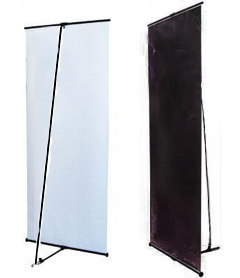
|
| BANNERS
|
 |
|
Most commonly a long, horizontal text and image print, banners must be flexible enough to support their own weight, and light enough to be hung with ease. Useful for both indoor and outdoor displays, banner material varies depending on the use. For indoor signs, fabric and even paper can work perfectly, while outside sturdy fabrics and vinyl (matte, scrim, gloss) are most common. For extremely large banners, a mesh material may be used to ensure wind can pass through the sign without tearing it.
Uses:
- Store front/side advertisements
- Sale signage
- Event advertisement
- Personal use (celebrations/announcements)
- Street-spanning advertisement
|

|
| BILLBOARDS
|
 |
|
Billboards are most often displayed at an extremely large size, 20-100 feet above the ground, intended to be seen and understood for the few seconds they are visible to passing vehicles. They often utilize short, catchy phrases or humor, bold colors, and large graphics. Due to their size, they are often printed on multiple strips of material, and put up in sections.
Since the media is generally glued to the rigid backing of the blank billboard, the material does not need to be particularly strong, but must withstand the elements (sunlight, rain, blown debris, snow, etc) for a period of time without ripping or fading. On the plus side, billboards are not generally required for long term display, as the company renting the space generally pays for a specific block of time.
Today, more and more billboards are turning away from traditional prints and instead opting for digital or LED displays, or prints mounted on many multi-sided, vertical bars that rotate at set intervals to show multiple displays.
Uses:
Advertising for businesses, events, hotels, products, etc.
Directions to venues within a city
Safe driving reminders
Real estate
Movies and television advertisements
Non-profit organizations
|
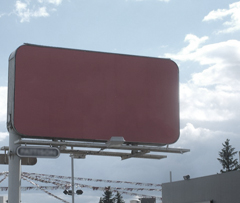
|
| CAD/TECHNICAL
|
 |
|
Printing documents for computer aided drafting/design or technical drawings is actually quite similar to producing regular graphics. This is because a high amount of detail is necessary in these prints, which will be used for architectural plans, showed to clients, and often entered in competitions for commissions.
Most drafting businesses have a high quality inkjet or laser printer capable of creating large prints (24x36" or larger). A high DPI (dots per inch) is necessary to ensure every small detail is very clear.
Uses:
- Building commissions
- Architecture plans
- Design portfolios
- Product designs
- 2D plans for 3D models
- 3D drawings
|

|
| FINE ART
|
 |
|
The printing industry is widely used to produce reproductions of original fine art pieces. Whether a digital copy is created by photography or scanning, a high quality inkjet printer can create prints up to three times the size of the original (depending on the DPI of the digital image). This service is used by artists who require prints of their work to sell at shows or online. It is also a common avenue for reproducing famous works of art.
Fine art print reproductions can be printed on canvas, to give them an authentic "painterly" appearance, or on a wide variety of fine art papers in finishes such as matte, smooth, textured, gloss, or satin. Photographs can also be printed in flawless quality. Most print companies offer archival inks that will not fade for 100 years, acid-free substrates, and protective sprays that prevent damage and discoloration.
Uses:
- Fine art photography
- Reproductions of works by the Masters (Monet, Van Gogh, etc)
- Prints for professional artists - sale and portfolios
- Digital reproductions for websites
- Copies of art for display in galleries/museums
- Canvas prints for home decor
|
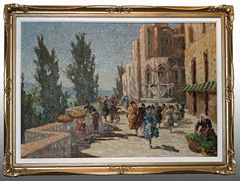
|
| GALLERY WRAPS
|
 |
|
The term "gallery wrap" describes the mounting style of a canvas print or original painting. In a gallery wrap, the image is extended beyond the visible front of the canvas, either by mirroring the edges or leaving the outer area uncropped. The canvas is stretched around stretcher bars (lengths of wood nailed together to form a frame) so that the imaged edges show along the sides of the piece.
The canvas is then folded neatly in the corners and stapled to the wood at the back. The result is a canvas that can be hung as is, without a frame, because no fasteners are visible from the front or sides of the artwork. A gallery wrap gives art a crisp, modern style that lets the art speak for itself without the flourish or distraction of a frame.
Uses:
- Fine art reproductions for the home
- Museum and gallery exhibits
- Sketches, paintings, drawings, digital art
- Wedding, infant, family, or nature photographs
|
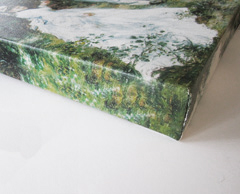
|
| INTERIOR DÉCOR
|
 |
|
The printing world contributes to interior decoration in myriad ways. From wall to furniture to floor, large scale images printed on paper and fabric are found in nearly every home. Since items in the home often see a lot of wear and tear, may require cleaning, and are exposed to UV light from both natural and manufactured sources, both the inks and the substrates must be able to hold up. This requires the use of strong papers and fabrics, and high quality inkjet inks that protect both image and background from fading and other destruction.
Uses:
- Wallpaper and large decal wall murals
- Furniture covers, from chairs and couches to lampshades
- Fine art for wall decoration and display
- Printed laminates for faux hardwood flooring
- Linens for curtains and draperies
|
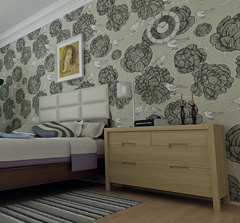
|
| INTERIOR FLOOR GRAPHICS
|
 |
|
Adhesive prints designed to be displayed on the ground are quite popular in stadiums, schools, and malls. Depicting anything from directional arrows to startlingly realistic images that meld the mind, these prints must be printed using strong inks, bold colors, and very durable substrates. The prints may be walked over by thousands of people a day, or even run or driven over.
Print companies that provide floor graphics use poly-based and vinyl media. The prints are treated to be UV- and moisture-resistant, and to protect against scuffing, tearing, peeling and regular traffic. A high quality floor graphic can last five years or even longer, depending on daily wear. Different adhesives adhere to linoleum, concrete, and even carpet.
Uses:
- Gymnasiums
- Athletic and clothing stores
- Stadiums and arenas
- Kids' bedrooms
- Unique business advertising
- Grocery stores
- Museums
- Stairs
- Three dimensional advertising
- Faux hardwood flooring
|
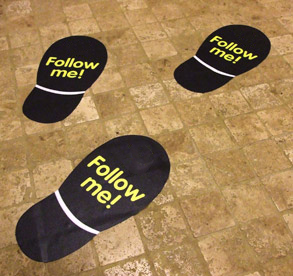
|
| OUTDOOR DECOR
|
 |
|
Printed media can also be used in outdoor decoration, from fabric to metal signage. Since these items will be exposed to the elements all the time, they must be created from sturdy, durable materials and printed with inks that will withstand weather. UV-curable and solvent inks are most commonly used for these purposes.
Depending on the intended longevity of the item, it may fade over time, or remain brightly colored. Coatings may be applied to both the media prior to printing, and to the completed image. These coatings will protect from water damage, discoloration, warping or peeling, and color bleeding.
Uses:
- Cushion covers for outdoor lounges and chairs
- Metal and wood prints for art and nameplates
- Garden markers on metal or plastic
- Wall and table coverings for decks/patios
- Curtains for gazebos and porches
- Planter decals
- Public art
|

|
| OUTDOOR SIGNAGE
|
 |
|
Banners and billboards are common examples of outdoor signage, but a wide range of materials may be used. These include rigid vinyl, metal, acrylic, PVC, wood, corrugated plastic and adhesive or magnetic material. Any material used outdoors must be able to withstand moisture and resist fading in direct sunlight. Solvent inks are generally used for outdoor displays, because the ink will eat into the material, making it last longer in more extreme environments. Latex inks are also used, and provide comparable fade and scratch resistance.
Uses:
- Large scale billboards
- Store front/side signage
- Event banners
- Real estate signs
- Sale announcements
- Vehicle decals
|

|
| PHOTOGRAPHS
|
 |
|
Under the category of art printing, photography is perhaps the most common order when customers shop for themselves. Any photograph can be printed of which a digital copy exists, and nearly every person has photographs that are special to them. Some of the most-requested categories include: family portraits, weddings and engagements, newborns, nature and wildlife, cityscapes, and pet photos.
Photos can be printed onto canvas and gallery wrapped, or printed on high quality photographic paper. These papers are available in metallic, matte, semi-matte, luster, semi-gloss, and glossy finishes, and each creates a unique, beautiful result. The inks used at most print shops are archival quality, which means the photographs should last for many decades, even as long as a century if properly framed and cared for.
Uses:
Home decor, for walls, tabletops, etc
Photographer portfolios
Gallery exhibits
Art reproductions
Photo studio decor
Memorabilia
Gifts and presentations
|
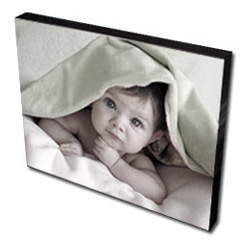
|
| P.O.P./INDOOR SIGNAGE
|
 |
|
P.O.P. stands for point-of-purchase, and refers to signs and advertisements located where the product shown is being sold (as opposed to billboards across town). It may also refer to advertisements attached to the stands on which the product is displayed. P.O.P. advertisements are seen within stores everyday, and at trade shows and events where a product is available for sale. These signs are usually printed in very bright, eye-catching colors, with loud slogans.
Because this type of signage will remain indoors, the material does not have to be as durable as that used in outdoor signs. Light vinyl, fabric, and even paper and cardboard may be used for signs displayed inside. Protective coatings may still be applied, to protect the print from customers brushing past or touching it, and UV damage from interior lights. Water-based inks are perfectly suitable for indoor signs.
Uses:
- Endcap displays in department and grocery stores
- Kiosks
- Booths at trade shows
- Sale signs in-store
- Liquidation or Closing Out
- Brand name imaging
|

|
| POSTERS
|
 |
|
Perhaps one of the first applications that comes to mind for large scale printing, posters are generally at least 18x24" and can depict everything from animals to celebrities to city skylines. Useful for both personal and commercial displays, posters are most often printed on a thin, glossy paper and ink that produces bold colors. For commercial applications, a matte paper may be used, that has been selected for its bright base - the best for bright, colorful reproductions.
Posters are easily laminated for longer lasting results and, due to the lightweight material, can usually be hung on the wall with only tape or push pins.
Uses:
- In-store wall and window product advertising
- Kids' and teen bedrooms
- Inexpensive art prints
- Theatre and concert advertisements
- Classrooms and school hallways
- Movie displays
- Community events and movements
- Subway and walkway walls
|

|
| PROOFING |
 |
|
Proofing, also known as prepress proofing (a reference to offset printing techniques) is the process of preparing a small print to test how the image looks, prior to producing a larger print or a run of many copies. Proofing minimizes waste by allowing the technician to correct any problems with the image, paper, or inks before more problematic copies are made. The proof can also be shown to the customer for any last minute edits or changes.
Proofing often utilizes less expensive papers that are guaranteed to behave like the paper that will be used on the official run. These papers are cheaper because they do not need to last, so they are not treated with UV-resistant or other protective coatings.
This type of proof is also known as a hard proof. If the technician refers to a "soft proof", this is a digital view of the image on a computer screen that has been calibrated to match the printer output as closely as possible.
Uses:
- Fine art reproductions - ensure color matching
- Photographic prints
- Large runs of flyers, posters, or pamphlets
- Business materials
- Mail outs
|
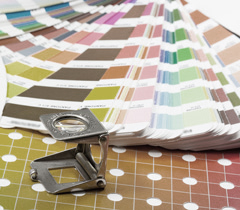
|
| SCREEN NEGATIVES/TRANSPARENCIES
|
 |
|
A screen or digital negative is a digital image with inverted colors that can be printed on a transparency and used to create a contact print. Unlike traditional film, digital negatives must be printed at the size they will be reproduced. This is because printers are unable to spray ink finely enough for a later enlargement.
Once the negative has been created with image editing software, it is printed on a transparent plastic sheet or film that will react much like traditional film when processed in a dark room on photographic papers.
Uses:
- Allows photographers to use digital cameras but produce traditional images
- Allows for manual adjustments to contrast, and manual dodging and burning
|
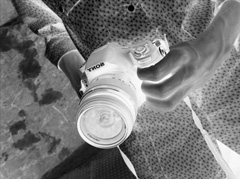
|
| SOFT SIGNAGE
|
 |
|
Soft signage is simply signs - generally for outdoor use - that are printed on fabric instead of the more traditional PVC, vinyl or paper. In addition to easy storage by simply rolling or folding the sign, soft signage is rapidly becoming cheaper and the quality is improving. Another plus of fabric signage is the ease with which it can be backlit.
For long term outdoor displays, dye-sublimation is the ideal option, as this printing method involves infusing the fabric with the inks from a printed image. However, solvent, latex and UV-curable inks are known for their durability as well. These inks are also excellent for indoor or short term banners, flags and other displays. Very large outdoor signs may require a mesh fabric to allow wind to pass through without ripping.
Uses:
- Store front/side signage
- Event banners
- Sale announcements
- Liquidation and Closing banners
- Auto lot banners and flags
- Street-side banners
- Trade shows
- Indoor shopping mall signage (ceiling draperies)
- Lamp post vertical banners
|
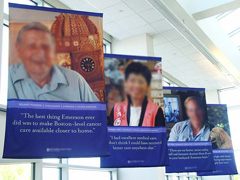
|
| TEMPORARY OUTDOOR SIGNAGE
|
 |
|
Very similar to the outdoor signage described above, temporary signs are banners and billboards that do not need to last a long time, and therefore can be made from less expensive or more diverse materials. These signs can still utilize rigid vinyl, metal, acrylic, PVC, wood, corrugated plastic and adhesive or magnetic material as substrates, but protective treatments and durable fibers are not as important. It is important, however, that the material be capable of withstanding moisture, since rain can ruin any outdoor display even overnight; water-based inks are not advisable for this reason. Concerns about fading in direct sunlight are not as vital, however. Solvent, UV curable, and latex inks are still preferable.
Uses:
Flash sales
One-day or weekend event advertising
Street directions to short term events
Baby or wedding shower banners
Wedding reception signs
Pop-up streetfront kiosks and booths
|
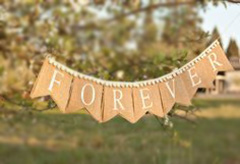
|
| TRADE SHOW GRAPHICS
|
 |
|
Because trade shows generally consist of a great number of different booths providing similar products and services, big and bold are essential for any graphics the business decides to display. Large metal or plastic apparatuses can be used to showcase six or eight foot high banners and signage that wrap around or flank the booth.
Flexible vinyl, paper, and fabric are most commonly used in trade show displays. Since the signage is generally displayed indoors and for short intervals, it does not need to withstand rain or heavy UV exposure, but nonetheless the material must stand up to bustling crowds brushing past and regular set up, take down, and repositioning. For this reason, a strong vinyl or fabric performs better than paper.
Again, since outdoor exposure is not an issue, water-based, solvent, latex, or UV-curable inks should work equally well, though latex and solvents are considered to produce the boldest color.
Uses:
- Point of Purchase displays
- Entrance displays to draw customers
- Ceiling displays for viewing from a distance
- Any application requiring immediate visual attention.
|

|
| VEHICLE GRAPHICS
|
 |
|
Printed, adhesive decals for vehicles have unlimited possibilities, and range from full coverage "vehicle wraps" to a small image or text on the window or side of the car or truck. The most important qualities a vehicle graphic must possess are color-fastness and easy removal. The colors must remain bold and bright to be the attention grabbing feature they are intended as, and since resale is always a consideration for vehicles, the graphics must peel off as easily as they went on.
Aside from basic colors, some graphic printing companies offer vehicle graphics in brushed steel and matte textures. The graphics are usually printed with solvent inks (bold colors, long lasting) on vinyl or PVC with an adhesive backing. This thin, flexible material can fit all the subtle curves of the vehicle to create a smooth cover. The finished print will have a clear, UV-protective coating applied to ensure the colors do not fade from the sunlight.
Uses:
- Advertising and branding on company vehicles
- Event advertising on company vehicles
- Business/event advertising on buses
- Personal decoration, racing stripes
- Airplane and train branding
|

|
| WALL MURALS
|
 |
|
Similar to wallpaper, digitally printed wall graphics are large-scale designs intended to cover a full wall. Though wallpaper material is available, vinyl and fabric adhesives are more popular these days. The graphic may be printed on one large sheet (less common, since it requires a very large printer), or in strips that will be applied side by side on the wall. Many options offer customers the option to remove and reposition the graphics many times without lessening their stickiness.
Because they are required to last for a long time, wall mural graphics must be printed on durable material that will not shrink, warp, or tear when applied or when nicked and scratched. Special coatings may be applied to the material both before and after it is printed. These coatings will protect from physical damage, as well as create a UV barrier to prevent fading from light exposure (both natural and manufactured). Aqueous (water-based) inkjet inks are perfectly suited to this product because they are intended to last for generations.
Uses:
- Kids' and teens' bedrooms
- Original, unique wallpaper for any room
- Office decor, branding
- Museums, galleries - can change with the exhibit
- Shopping mall advertising
- Sports logos in arenas
|

|
| WINDOW GRAPHICS
|
 |
|
Much like wall murals, window graphics must be adhesive. Since they are affixed to the outside of the window, the adhesive must be extremely strong, to prevent rain, debris, and passersby from chipping away at the decal. Display options range from small logos or business names to full coverage graphics which provide not only advertising and eye-catching decoration, but also conceal the interior. If the natural light is desired in the interior, perforated materials are available that appear opaque from the outside, but allow light through, and can be seen through, from the unprinted side.
A clear laminate will be applied to the solvent or UV-curable ink image once it is printed, to ensure it does not fade while exposed consistently to sunlight. If properly produced, window graphics can last for years without noticeable fading or degradation.
Uses:
- Business advertising
- Event advertising
- Store front branding
- Privacy windows
|

|
|
© 2002-2025 - KeenART Media Ltd.
|
|
| |
|
